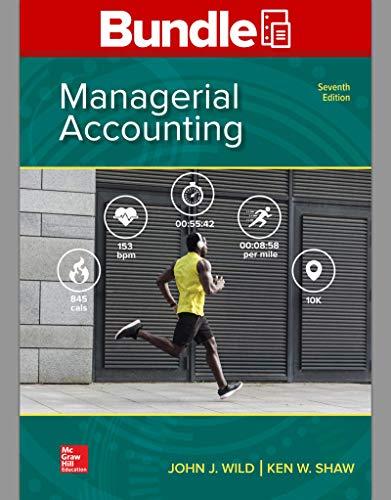
Exercise 22-16 Performance measures-balanced scorecard A3
USA Airlines uses the following performance measures. Classify each of the performance measures below into the most likely balanced scorecard perspective it relates to. Label your answer using C (customer), P (internal process), I (innovation and growth), of F(financial).
___1.
___2. Number of reports of mishandled or lost baggage
___3. Percentage of on-time departures
___4. On-time fight percentage
___5. Percentage of ground crew trained
____6.
____7. Market value
____8. Accidents or safety incidents per mile flown
____9. Customer complaints
____10. Flight attendant training sessions attended
____11. Time airplane is on ground between flights
____12. Airplane miles per gallon of fuel
____13. Revenue per seat
____14. Cost of leasing airplanes
Want to see the full answer?
Check out a sample textbook solution
Chapter 9 Solutions
Managerial Accounting + Connect Access Card
- Can you solve this general accounting problem with appropriate steps and explanations?arrow_forwardPlease provide the answer to this general accounting question using the right approach.arrow_forwardI am looking for the correct answer to this financial accounting problem using valid accounting standards.arrow_forward
 Managerial Accounting: The Cornerstone of Busines...AccountingISBN:9781337115773Author:Maryanne M. Mowen, Don R. Hansen, Dan L. HeitgerPublisher:Cengage Learning
Managerial Accounting: The Cornerstone of Busines...AccountingISBN:9781337115773Author:Maryanne M. Mowen, Don R. Hansen, Dan L. HeitgerPublisher:Cengage Learning Financial & Managerial AccountingAccountingISBN:9781337119207Author:Carl Warren, James M. Reeve, Jonathan DuchacPublisher:Cengage Learning
Financial & Managerial AccountingAccountingISBN:9781337119207Author:Carl Warren, James M. Reeve, Jonathan DuchacPublisher:Cengage Learning Survey of Accounting (Accounting I)AccountingISBN:9781305961883Author:Carl WarrenPublisher:Cengage Learning
Survey of Accounting (Accounting I)AccountingISBN:9781305961883Author:Carl WarrenPublisher:Cengage Learning Accounting (Text Only)AccountingISBN:9781285743615Author:Carl Warren, James M. Reeve, Jonathan DuchacPublisher:Cengage LearningPrinciples of Accounting Volume 2AccountingISBN:9781947172609Author:OpenStaxPublisher:OpenStax College
Accounting (Text Only)AccountingISBN:9781285743615Author:Carl Warren, James M. Reeve, Jonathan DuchacPublisher:Cengage LearningPrinciples of Accounting Volume 2AccountingISBN:9781947172609Author:OpenStaxPublisher:OpenStax College Managerial AccountingAccountingISBN:9781337912020Author:Carl Warren, Ph.d. Cma William B. TaylerPublisher:South-Western College Pub
Managerial AccountingAccountingISBN:9781337912020Author:Carl Warren, Ph.d. Cma William B. TaylerPublisher:South-Western College Pub





